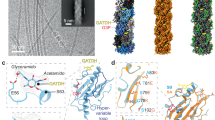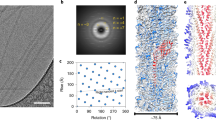Abstract
TYPE-4 pilus-mediated adherence of Neisseria gonorrhoeae and Neisseria meningitidis is considered to be a crucial early event in neisserial infections1,2. In addition to the principal pilus subunit (pilin or PilE), both pathogens produce low quantities of a phase-variable PilC protein which is implicated in pilus biogenesis and pilus-mediated epithelial cell adherence3,4. The identity, however, of the pilus adhesin has remained obscure4,5. Here we describe the isolation of a PilC protein from a gonococcal overproducing strain and demonstrate its specific interaction with human epithelial cells. Our results are consistent with the cell and species tropisms of neisserial infections. Binding of PilC effectively competes with pilus-mediated, but not Opa-mediated6, attachment of N. gonorrhoeae and of N. meningitidis, indicating that both pathogens interact with identical or very similar epithelial cell receptors. Immunogold electron microscopy using antisera raised against purified PilC and synthetic peptides locates PilC at the tip of gonococcal pili. PilC thus represents an essential pilus-associated adhesin, providing a rationale for selective protection against neisserial infections.
This is a preview of subscription content, access via your institution
Access options
Subscribe to this journal
Receive 51 print issues and online access
$199.00 per year
only $3.90 per issue
Buy this article
- Purchase on Springer Link
- Instant access to full article PDF
Prices may be subject to local taxes which are calculated during checkout
Similar content being viewed by others
References
Kellogg, D. S., Cohen, I. R., Norins, L. C., Schroeter, A. L. & Reising G. J. Bact. 96, 596–605 (1968).
Swanson, J. et al. J. exp. Med. 165, 1016–1025 (1987).
Jonsson, A.-B., Nyberg, G. Normark, S. EMBO J. 10, 477–488 (1991).
Rudel, T., van Putten, J. P. M., Gibbs, C. P., Haas, R. & Meyer, T. F. Molec. Microbiol. 6, 3439–3450 (1992).
Nassif, X. et al. Proc. natn. Acad. Sci. U.S.A. 91, 3769–3773 (1994).
Makino, S., van Putten, J. P. M. & Meyer, T. F. EMBO J. 10, 1307–1315 (1991).
Pohlner, J., Krämer, J. & Meyer, T. F. Gene 130, 121–126 (1993).
Sastry, P. A., Pearlstone, J. R., Smillie, L. B. & Paranchych, W. FEBS Lett. 151, 253–255 (1983).
Girón, J. A., Suk Yue Ho, A. & Schoolnik, G. K. Science 254, 710–713 (1991).
Girón, J. A., Levine, M. L. & Kaper, J. B. Molec. Microbiol. 12, 71–82 (1994).
Shaw, C. E. & Taylor, R. K. Infect. Immun. 58, 3042–3049 (1990).
Ogierman, M. A., Zabihi, S., Mourtzios, L. & Manning, P. A. Gene 126, 51–60 (1993).
Kuehn, M. J., Heuser, J., Normark, S. & Hultgren, S. J. Nature 356, 252–255 (1992).
Muir, L. L., Strugnell, R. A. & Davies, J. K. Infect. Immun. 56, 1743–1747 (1988).
Parge, H. E. et al. J. biol. Chem. 265, 2278–2285 (1990).
Johnson, S. C. et al. J. Infect. Dis. 163, 128–134 (1991).
Lee, K. K. et al. Molec. Microbiol. 11, 705–714 (1994).
Meyer, T. F., Billyard, E., Haas, R., Storzbach, S. & So, M. Proc. natn. Acad. Sci. U.S.A. 81, 6110–6114 (1984).
Hagblom, P., Segal, E., Billyard, E. & So, M. Nature 315, 156–158 (1985).
Haas, R., Veit, S. & Meyer, T. F. Molec. Microbiol. 6, 197–208 (1992).
Meyer, T. F., Pohlner, J. & van Putten, J. P. M. Curr. Top. Microbiol. Immun. 192, 283–317 (1994).
Virji, M., Alexandrescu, C., Ferguson, D. J. P., Saunders, J. R. & Moxon, E. R. Molec. Microbiol. 6, 1271–1279 (1992).
Nassif, X. et al. Molec. Microbiol. 8, 719–725 (1993).
Virji, M. et al. Molec. Microbiol. 10, 1013–1028 (1993).
Rothbard, J. B., Fernandez, R., Wang, L., Teng, N. N. H. & Schoolnik, G. K. Proc. natn. Acad. Sci. U.S.A. 82, 915–919 (1985).
Hochuli, E., Döbeli, H. & Schacher, A. J. Chromatogr. 411, 177–184 (1987).
Wang, J. et al. Infect. Immun. 60, 5267–5282 (1992).
Author information
Authors and Affiliations
Rights and permissions
About this article
Cite this article
Rudel, T., Scheuerpflug, I. & Meyer, T. Neisseria PilC protein identified as type-4 pilus tip-located adhesin. Nature 373, 357–359 (1995). https://doi.org/10.1038/373357a0
Received:
Accepted:
Issue Date:
DOI: https://doi.org/10.1038/373357a0
This article is cited by
-
Cell type specific polyploidization in the royal fat body of termite queens
Zoological Letters (2023)
-
Tree-ring oxygen isotopes record a decrease in Amazon dry season rainfall over the past 40 years
Climate Dynamics (2022)
-
PilY1 and minor pilins form a complex priming the type IVa pilus in Myxococcus xanthus
Nature Communications (2020)
-
A journey into the brain: insight into how bacterial pathogens cross blood–brain barriers
Nature Reviews Microbiology (2017)
-
Novel anti-infective potential of salvianolic acid B against human serious pathogen Neisseria meningitidis
BMC Research Notes (2016)
Comments
By submitting a comment you agree to abide by our Terms and Community Guidelines. If you find something abusive or that does not comply with our terms or guidelines please flag it as inappropriate.



